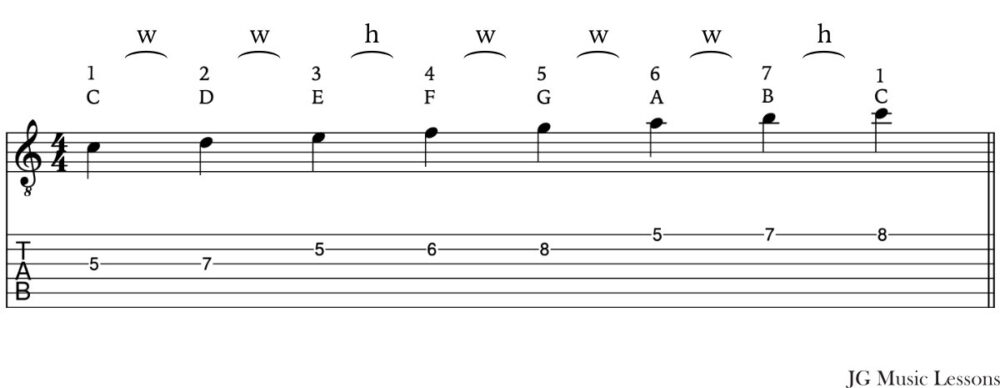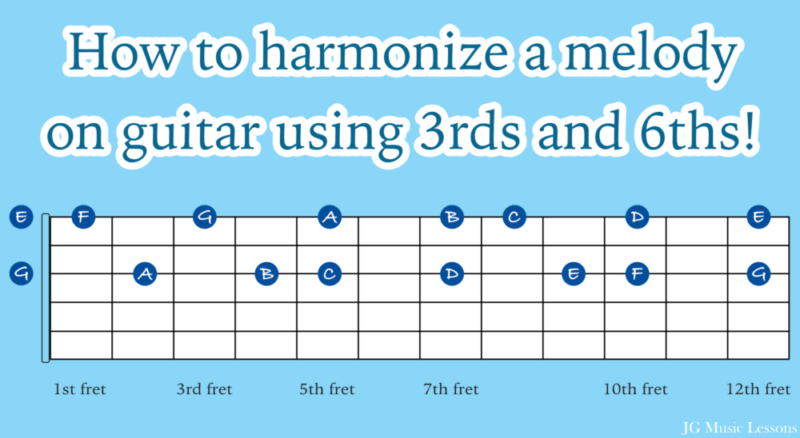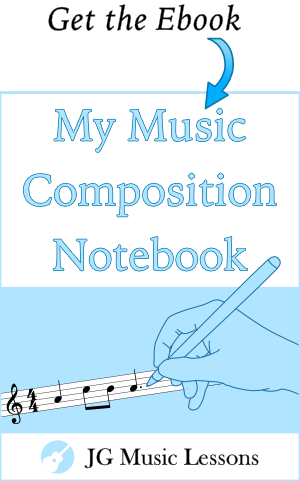There are many ways you can enhance single notes lines when playing melodies or improvising on guitar. One way we can do this is by learning to harmonize a melody which simply means to add notes above or below a melody or phrase to add depth and expression to the music you are playing.
In this lesson, you will learn to use different intervals, which simply means a specific distance from one note to another note. We will focus on using the intervals of 3rds and 6ths to make your melodies sound nicer!
If you haven’t already, I first recommend learning the 5 Major scale shapes before learning how to harmonize a melody. With that being said, let’s take a look at how you can start applying this concept of 3rds and 6ths intervals.
Identify which scale to use
The first thing you should know is that a series of notes come from a scale. The notes of a particular scale will make up the melody or some parts of a song. The first scale you want to learn is the C Major scale and understand the formula that makes up a Major scale (the distance between each note). See how the whole and half steps make up this Major scale:

Once you know this formula that makes up a Major scale, you can also apply this to start on any given note to find the notes of other Major scales.
How to harmonize a melody in 3rds
Once you know what scale you are using, you can start adding other notes based on that scale. First, we’ll try playing in intervals of thirds, meaning that you take a note of a scale and then play the third note above it. For example, in C Major you would play C and E, D and F, E and G, and so on.
You basically take a note and then skip the following note of the scale to get a third above the melody note.
This is what the Major scale looks like with 3rds above each note and also how you could play this on the guitar. Make sure to check the numbers above the notes to help you choose a comfortable fingering on your fretting hand.

Melody example in C
Here is a short melody in the key of C Major. A key or key signature simply means the starting point that defines the rest of the notes of a scale.

Here is a backing track of what this melody sounds like:
Now try this example of the same melody now with the interval of a third above the notes.
3rds above the melody

3rds below the melody
You can also try thirds below the notes by skipping the previous note of the scale.
Here is what this would like:

How to harmonize a melody in 6ths
You can also apply the concept of harmonization with intervals of 6ths like we did with 3rds. Harmonized 6ths on guitar create a fuller sound and add more depth to the melody line.
6ths above the melody
Here is the same melody with the interval of a 6th above:

6ths below the melody
And the same melody with the interval of a 6th below:

Harmonization tips to create variations in music
Harmonizing notes is also a great tool to create variations in music. You might want to play a single line the first time around and then harmonize the melody to create a variation.
Let’s see some examples below.
Variation 1
In this example, I started measures 1 and 2 with the original melody. Then I used 6ths above the melody on measure 3 and the 3rds above the melody on measure 4 to provide some contrast when repeating the phrase.

Breaking up intervals (Variation 2)
Another nice compositional tool you can add to your playing is to break up up the intervals into different rhythms to create a nice musical pattern.
Here is an example where we can split up some intervals of 6ths in 8th notes. I only add these rhythm variations to the notes that were originally half notes since we have some space to fill in there.

You can add these kinds of intervals to certain phrases or sections of a piece of music. As you practice these intervals, you will also get better at knowing when it sounds tasteful to add extra parts to a melody.
Melody harmonization exercises
To practice this concept of harmonizing a melody, take any scale and make sure you can play and name each note consecutively. You can learn key signatures to effectively remember the notes to any scale.
Then to practice playing thirds above, be able to name each note above every scale note. This way you don’t have to guess what the right notes are when putting the harmony together. Then try the same with thirds below the scale notes.
I would first focus on trying to play this on the 1st and 2nd strings since you will tend to play melodies in a higher range. Then you can try this on the 2nd and 3rd strings, and so on.
You can then apply this same exercise with intervals of 6ths to be able to harmonize any note in any key.
Also, practice harmonizing notes in both ascending and descending directions to make it easier when you have to do this with a melody.
One final tip is that it helps to know what chords are related in a chord progression. You can use the same scale to harmonize notes over a series of related chords rather than thinking of a different scale for every chord.
Wrapping up
To recap what we covered in this lesson, the way you can learn to harmonize a melody on guitar is to understand what key and scale you need to use. Again, I recommend learning your 5 Major scale shapes really well so that you can add different intervals above or below melody notes.
Using the intervals of 3rds and 6ths are the most common ones you will most likely hear in songs. These intervals sound great and you can use them with melodies that you like or that you might want to try writing yourself.
After learning to use intervals of 3rds and 6ths, you could explore harmonizing with other intervals such as such as 4ths, 5ths, or 7ths which I mention in this lesson on how to practices scales.
Have fun spicing up melodies you already know or when composing your own music!
📘 Get the free guitar practice guide here!
All the best,
JG





